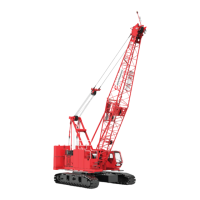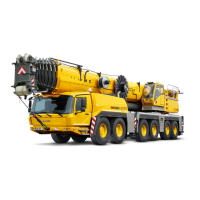OPERATING CONTROLS AND PROCEDURES MLC650 OPERATOR MANUAL
3-72
Published 08-12-19, Control # 224-13
Travel Operation
1. Before traveling:
• Check for travel restrictions. See the Maximum
Allowable Travel Specifications chart in the
Capacity Chart Manual.
• Plan the travel route. It must be firm, level, and free
of obstructions. Do not exceed the grades specified
in the Maximum Allowable Travel Specifications
chart.
• Check the crawlers for proper adjustment.
• Warn personnel to stand clear of the travel area. Do
not travel without a signal person.Turn off the
travel park switch.
2. For travel with load, position the boom within the
applicable capacity chart. Carry the load as close to the
ground as possible. Stabilize the load with taglines.
3. For travel without load, carry the load block and the
weight ball low enough that they cannot swing into the
boom or jib. If desired, tie off the load block at the front of
the rotating bed.
WARNING
Tipping Hazard
The travel surface must be firm and uniformly supporting.
Refer to the Maximum Allowable Travel Specifications
chart in the Capacity Chart Manual for:
• Travel specifications with load
• Travel specifications without load
Failure to comply with the Maximum Allowable Travel
Specifications can result in tipping.
Moving Crane Hazard
Know the position of the rotating bed with relation to the
front of the carbody before traveling. An accident can
result if the crane travels opposite of the intended
direction.
• The boom is at the front of the upperworks.
• A yellow arrow and dot on the left top and left front
sides of the carbody indicate the FRONT of the
carbody.
Flying Object Hazard
Excessive dirt build-up at the tumbler and the front roller
ends of crawlers can result in excessive tension in tread
connectors. The tread connectors can break if over
tensioned, causing the treads to fly apart unexpectedly
with dangerous force.
CAUTION
Accelerated Crawler Wear
To reduce the wear and tear of the crawler components
(treads, rollers, frames), try not to allow dirt to pile up at
the tumbler and the front roller ends of the crawlers.
Dirt can pile up when turning on soft surfaces. To avoid
this:
• Bring crawlers to a complete stop before changing
direction of travel.
• Turn a few degrees. Then slowly travel forward or
reverse so dirt falls away from the crawlers. Continue
this procedure until the desired turn has been made.
• Avoid sharp turns if possible.
• Make gradual turns or counter-rotate whenever
possible so both crawlers are always powered.
• Clean the crawlers often.
Keep the crawler treads properly adjusted.
CAUTION
Boom Damage
Abrupt travel operation could result in shock loading the
boom and rigging. To avoid this, perform all travel
functions—starting, turning, stopping—slowly and
smoothly.
Figure 3-21. Crawler Handles
